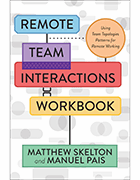Remote communication best practices need mindful approach
Authors Matthew Skelton and Manuel Pais discuss how to apply the lessons from their 'Remote Teams Interactions Workbook' to develop remote communication best practices for teams.
The transition to remote work at the onset of the COVID-19 pandemic was sudden for many organizations, and employees had to quickly adapt to new ways of communicating. To achieve success with remote work in the long term, organizations need to examine how teams communicate and set remote communication best practices to ensure effective collaboration.
In the book Remote Team Interactions Workbook, authors Matthew Skelton and Manuel Pais provide guidance and exercises to help organizations examine communication patterns, identify team dependencies and build trust among teams when collaborating remotely.
In this interview, Skelton and Pais discussed how to apply lessons from the workbook to manage collaboration tool sprawl, prepare for the hybrid workforce and address why improving remote team communications is an ongoing process.
Editor's note: This interview has been edited for length and clarity.
How can this framework help teams manage collaboration tool sprawl and determine the best method of communication for a specific workflow?
Matthew Skelton: I think there's a step back from there, which is, in a remote-first context, the way in which we think about tools ends up being very different. For example, early on in the pandemic, lots of organizations adopted video calling technology, like Zoom, Microsoft Teams or Google Meet, and tried to get people in meetings as if they were in a physical room. And that's just exhausting. All-day-long video calls just don't work.
 Matthew Skelton
Matthew Skelton
It's not just about replacing things in the office with something equivalent online. It's the way you go about work that actually needs to be different -- and it can actually be more effective. We're now much more deliberate about the kind of communication we're doing. And that's a key aspect about the Remote Teams Interaction Workbook. It's a key aspect of team topologies to be much more mindful, much more considerate about the kind of interactions we have among different teams in the organization and why. The Remote Team Interactions Workbook follows that approach and encourages people to be much more deliberate about what they're doing when they're communicating.
 Manuel Pais
Manuel Pais
Manuel Pais: The problem with the tools, and the way they've been rolled out in many organizations, is that, suddenly, people were having a lot of added cognitive load that we talked about in Team Topologies. In the workbook, we provide some examples of how to assess cognitive load on teams because, suddenly, a lot of organizations rolled out a number of new tools quickly to try to keep the same workflow. But, as Matthew said, workflow shouldn't necessarily be the same remotely as it was in the office.
As organizations evaluate hybrid workplace options, how can they apply the framework they've built for remote teams to a hybrid office?
Skelton: What seems to be effective is organizations adopt techniques that work well for a remote context and apply those everywhere. For example, one of the approaches we talk about in the book is a naming scheme for your chat tool. Let's say you're using Slack. How do you find the right channel? How do you know where to go? How do you know what kind of options are available? Without a sensible naming scheme, you're going to be hunting around for the right place to go. But, if there's a sensible naming scheme, where it's easy to discover the information, you can self-service and find a place to have that conversation.
That approach works in an in-person office situation because, in reality, modern organizations are going to be using a chat tool like Slack. If it's useful remotely, then it's also useful in the office because, rather than running around the office trying to find someone, it's discoverable. You can spend office time in front of other people doing much more useful things, like actually building that sense of a team, building trust, whiteboarding, which you can't do as easily remotely.
Pais: Essentially, the principles that we're talking about to make remote interactions effective are the same principles you would expect in the office as well. Ideally, even if we're talking about physical space, you would like to promote fluid communication inside the teams. Inside a single team, you would expect them to be able to communicate very quickly. In the office, that would mean you would expect the team to be sitting together; you don't just spread people around because that makes it very difficult to communicate.
We're intentionally and actively thinking about what kind of communication should be strong inside a given team and then thinking about which teams need to communicate on a regular basis. Whether it's in the office or in the chat tools, make it easy to do and to discover the right place to communicate or collaborate with another team.
Then, also, look at where there is noise -- if there's a lot of communication happening between certain teams that you don't really expect because you were expecting them to work more independently. That's a signal that maybe we need to look at how these teams can be more decoupled if that's impacting our ability to go faster and to deliver and to respond to customers faster.
What is the most effective way for readers to use the exercises at the end of each chapter to evaluate their own team communications?
Skelton: In this book, we're expecting the value to be substantial for people actually reading this stuff and then going and trying out the ideas. Some of the examples people can try individually themselves: Think about naming schemes; think about defining their team API. Our first book together was Team Topologies; it's all about how the starting point is teams. The best place to start would be to bring the team together in a meeting and work on it as a team.
And some of these exercises don't take long -- 15 minutes will probably do for some of them. A good chunk of the value in something like this is getting the team to realize something together, building a shared understanding and increasing trust by realizing everyone now pretty much has a new way of thinking about this thing or sees an improved way of doing something. That becomes quite powerful. The short version of my answer is to basically run these exercises as a team because that's where the power is going to be.
What would you consider the key takeaway for readers of the workbook?
Skelton: For many people, the idea of designing communication is really weird, but that's effectively what we're doing here. In Team Topologies, we talk about designing the ecosystem in which an organization can evolve. Where we're thinking about remote team interactions, we're effectively talking about designing those interactions but being much more conscious about how those interactions or communication can and should happen. It's useful in an office context. In the past, organizations that were working well in-office had some design, or a design emerged based on ground rules or culture that wasn't necessarily always written down. What we're doing here is making this explicitly clear by writing it down and providing some fairly basic patterns for interaction.
We need to be actively shaping the kind of conversations happening among different groups in the organization if we're going to have more success as an organization. That's what the Remote Team Interactions Workbook partly provides in combination with the Team Topologies book.
Pais: The thing I would stress as well is that people should not expect to read the workbook, do the all the exercises, apply the ideas and suddenly find the ideal way of working remotely.
Just like with the first book, Team Topologies, the point is really to iterate. When we talk about iterating your organization, your teams, directions, here, we should be expecting the same. You might start with some of the techniques we talk about. You might start with some aspects that are more challenging today, whether it's cognitive loading teams or the lack of good naming conventions for your communications and chat tools. But you should expect, over time, that you're going to have to iterate and evolve this approach as you learn more about what works well and what doesn't work so well for your organization in terms of remote working.
It's never going to be one step we just apply, and suddenly, we're in some sort of ideal state. It's always going to be a journey of discovering and improving continuously.









